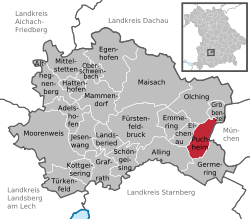Puchheim
| Puchheim | ||
|---|---|---|
| ||
 Puchheim | ||
Location of Puchheim within Fürstenfeldbruck district  | ||
| Coordinates: 48°09′N 11°21′E / 48.150°N 11.350°ECoordinates: 48°09′N 11°21′E / 48.150°N 11.350°E | ||
| Country | Germany | |
| State | Bavaria | |
| Admin. region | Oberbayern | |
| District | Fürstenfeldbruck | |
| Government | ||
| • Mayor | Norbert Seidl (SPD) | |
| Area | ||
| • Total | 12.23 km2 (4.72 sq mi) | |
| Population (2015-12-31)[1] | ||
| • Total | 21,111 | |
| • Density | 1,700/km2 (4,500/sq mi) | |
| Time zone | CET/CEST (UTC+1/+2) | |
| Postal codes | 82178 | |
| Dialling codes | 089 | |
| Vehicle registration | FFB | |
| Website | www.puchheim.de | |
Puchheim is a city near Munich in the district of Fürstenfeldbruck, in Bavaria, Germany. It has about 20,000 inhabitants, and is located at 48°09′N 11°21′E / 48.150°N 11.350°E. Puchheim is divided into two parts: the old and rural part called Puchheim-Ort and the new part of Puchheim (Puchheim Bahnhof) that was founded when the S-Bahn (a quick train commuting to Munich) was built. Before that there was one of the first civil airfields in Bavaria, which was later used as a prisoner of war camp during World War I.[2] The area around the camp was dried up by workers from the POW camp, so that houses could be built.
The old part of Puchheim is even older than Munich.
Puchheim is well connected to the regional and national traffic network by S-Bahn ![]() (S4) and Autobahn (A 8, A 99)
(S4) and Autobahn (A 8, A 99)
| Wikimedia Commons has media related to Puchheim. |
References
- ↑ "Fortschreibung des Bevölkerungsstandes". Bayerisches Landesamt für Statistik und Datenverarbeitung (in German). June 2016.
- ↑ "Aus der Geschichte Puchheims". Stadt Puchheim (City of Puchheim). Retrieved 1 March 2014.
